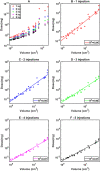A computational modeling approach for dosing endoscopic intratumoral chemotherapy for advanced non-small cell lung cancer
- PMID: 34996946
- PMCID: PMC8741990
- DOI: 10.1038/s41598-021-03849-w
A computational modeling approach for dosing endoscopic intratumoral chemotherapy for advanced non-small cell lung cancer
Abstract
We recently developed a computational model of cisplatin pharmacodynamics in an endobronchial lung tumor following ultrasound-guided transbronchial needle injection (EBUS-TBNI). The model suggests that it is more efficacious to apportion the cisplatin dose between injections at different sites rather than giving it all in a single central injection, but the model was calibrated only on blood cisplatin data from a single patient. Accordingly, we applied a modified version of our original model in a set of 32 patients undergoing EBUS-TBNI for non-small cell lung cancer (NSCLC). We used the model to predict clinical responses and compared them retrospectively to actual patient outcomes. The model correctly predicted the clinical response in 72% of cases, with 80% accuracy for adenocarcinomas and 62.5% accuracy for squamous-cell lung cancer. We also found a power-law relationship between tumor volume and the minimal dose needed to induce a response, with the power-law exponent depending on the number of injections administered. Our results suggest that current injection strategies may be significantly over- or under-dosing the agent depending on tumor size, and that computational modeling can be a useful planning tool for EBUS-TBNI of cisplatin in lung cancer.
© 2022. The Author(s).
Conflict of interest statement
JHTB is a consultant for Johnson & Johnson on matters related to this study, and is co-applicant on the patent application “Methods for computational modeling to guide intratumoral therapy.” U.S. Patent Application No. 62/542,623. Filed: August 8, 2017. CMK is a consultant for Olympus America, Johnson and Johnson, and consultant and equity holder for Quantitative Imaging Solutions. He serves on the steering committee for Nuvaira and the Scientific Advisory Board for Galvanize Therapeutics. He reports grants from the NIH, clinical trial funding through Johnson and Johnson, and is a co-applicant on the patent application "Methods for computational modeling to guide intratumoral therapy". U.S. Patent Application No. 62/542,623. Filed: August 8, 2017.” VM, MJ and HM declare that there are no conflict of interest.
Figures




Similar articles
-
Cisplatin Pharmacodynamics Following Endobronchial Ultrasound-Guided Transbronchial Needle Injection into Lung Tumors.Sci Rep. 2019 May 2;9(1):6819. doi: 10.1038/s41598-019-43270-y. Sci Rep. 2019. PMID: 31048709 Free PMC article.
-
Endobronchial ultrasound-guided transbronchial needle injection of cisplatin results in dynamic changes in the tumor immune microenvironment.Respir Med Res. 2023 Nov;84:100994. doi: 10.1016/j.resmer.2023.100994. Epub 2023 Jan 10. Respir Med Res. 2023. PMID: 37307616
-
Endobronchial Ultrasound-guided Intratumoral Injection of Cisplatin for the Treatment of Isolated Mediastinal Recurrence of Lung Cancer.J Vis Exp. 2017 Feb 12;(120):54855. doi: 10.3791/54855. J Vis Exp. 2017. PMID: 28287519 Free PMC article.
-
Role of endobronchial ultrasound-guided transbronchial needle aspiration in lung cancer management.Expert Rev Respir Med. 2019 Sep;13(9):863-870. doi: 10.1080/17476348.2019.1646642. Epub 2019 Jul 24. Expert Rev Respir Med. 2019. PMID: 31322034 Review.
-
Adequacy of Samples Obtained by Endobronchial Ultrasound with Transbronchial Needle Aspiration for Molecular Analysis in Patients with Non-Small Cell Lung Cancer. Systematic Review and Meta-Analysis.Ann Am Thorac Soc. 2018 Oct;15(10):1205-1216. doi: 10.1513/AnnalsATS.201801-045OC. Ann Am Thorac Soc. 2018. PMID: 30011388
Cited by
-
Clinical Applications of Endobronchial Ultrasound (EBUS) Scope: Challenges and Opportunities.Diagnostics (Basel). 2023 Aug 1;13(15):2565. doi: 10.3390/diagnostics13152565. Diagnostics (Basel). 2023. PMID: 37568927 Free PMC article. Review.
-
Intratumoral Chemotherapy: The Effects of Drug Concentration and Dose Apportioning on Tumor Cell Injury.Bioengineering (Basel). 2024 Aug 9;11(8):809. doi: 10.3390/bioengineering11080809. Bioengineering (Basel). 2024. PMID: 39199767 Free PMC article.
-
In Situ Synthesis of a Tumor-Microenvironment-Responsive Chemotherapy Drug.Pharmaceutics. 2023 Apr 21;15(4):1316. doi: 10.3390/pharmaceutics15041316. Pharmaceutics. 2023. PMID: 37111800 Free PMC article.
-
The evolution of endobronchial ultrasound usage in modern era.Tuberk Toraks. 2023 Sep;71(3):299-307. doi: 10.5578/tt.20239711. Tuberk Toraks. 2023. PMID: 37740633 Free PMC article. Review.
-
Functional biomaterials for biomimetic 3D in vitro tumor microenvironment modeling.In Vitro Model. 2023 Jan 27;2(1-2):1-23. doi: 10.1007/s44164-023-00043-2. eCollection 2023 Apr. In Vitro Model. 2023. PMID: 39872875 Free PMC article. Review.
References
-
- Organization WH . Fact Sheet: Cancer. WHO; 2018.
-
- Howlader N, Noone A, Krapcho M. SEER Cancer Statistics Review, 1975–2014, Based on November 2016 SEER Data Submission. National Cancer Institute; 2017.
-
- Khan, F., Anker, C.J., Garrison, G., Kinsey, C.M. Endobronchial ultrasound–guided transbronchial needle injection for local control of recurrent non–small cell lung cancer. Ann. Am. Thorac. Soc.12, 101–104 (2015). - PubMed
-
- Goldberg, E.P., Hadba, A.R., Almond, B.A., Marotta, J.S. Intratumoral cancer chemotherapy and immunotherapy: Opportunities for nonsystemic preoperative drug delivery. J. Pharm. Pharmacol.54, 159–180 (2002). - PubMed
Publication types
MeSH terms
Substances
Grants and funding
LinkOut - more resources
Full Text Sources
Medical

